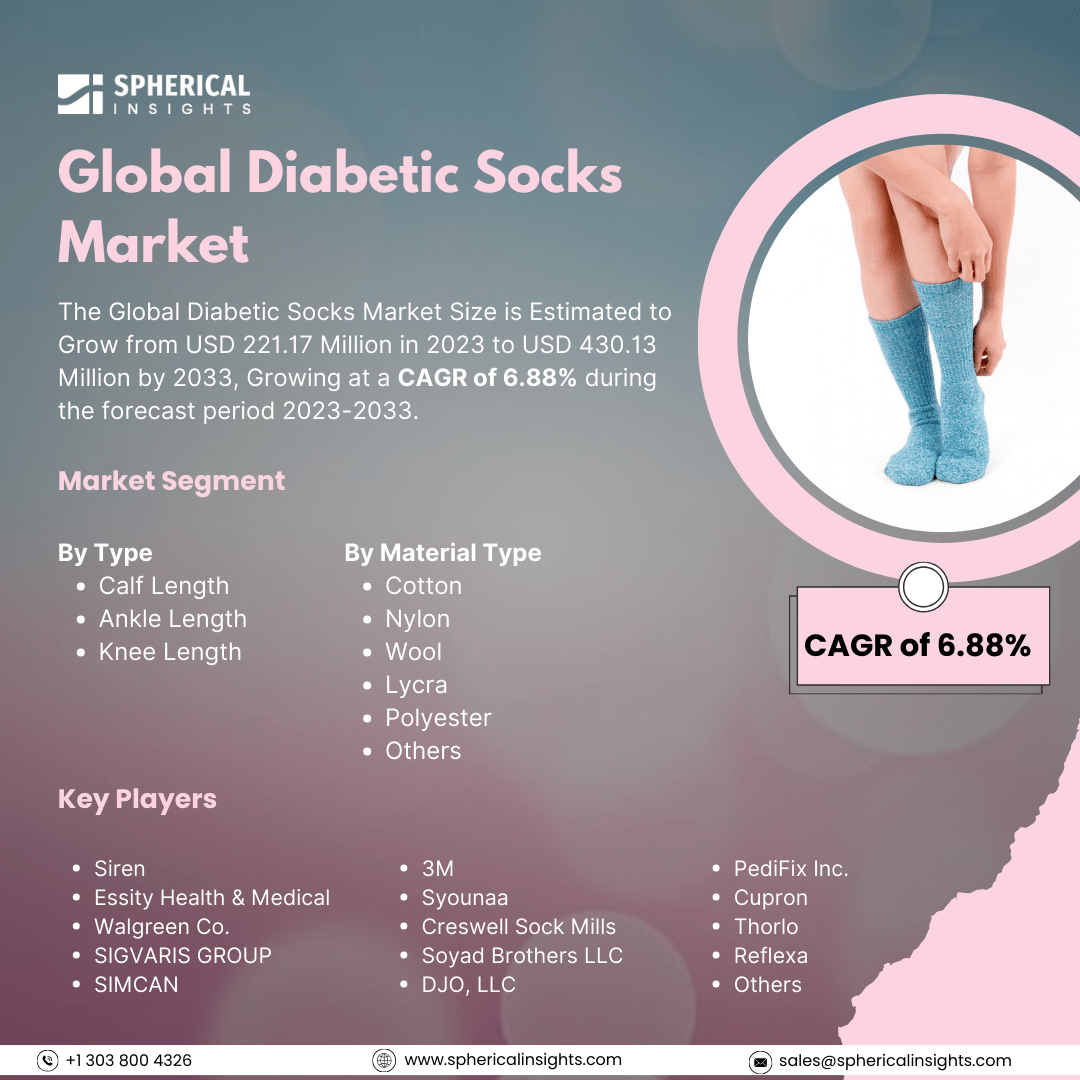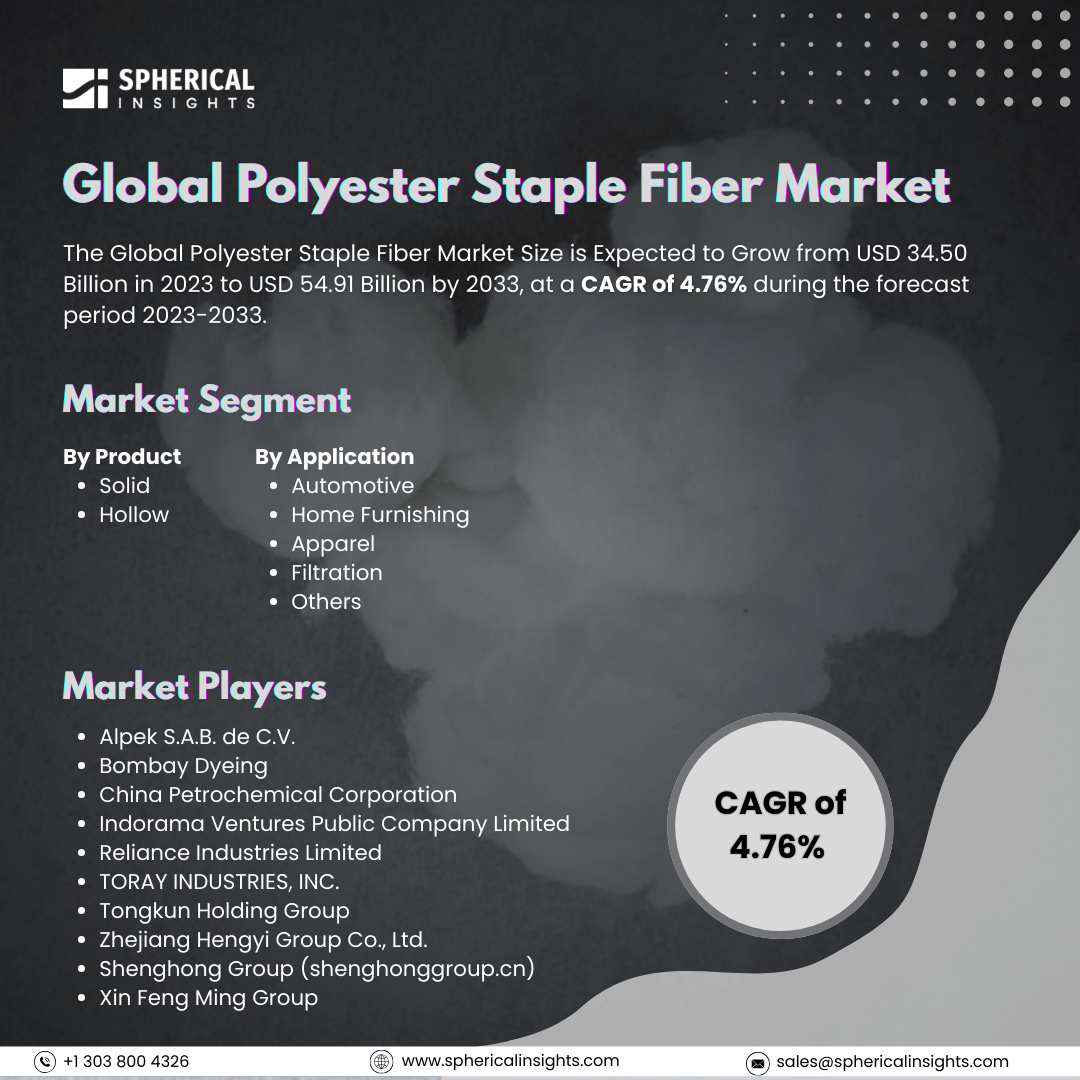Global Diabetic Socks Market Size to Worth USD 430.13 Million by 2033
According to a research report published by Spherical Insights & Consulting, The Global Diabetic Socks Market Size is Estimated to Grow from USD 221.17 Million in 2023 to USD 430.13 Million by 2033, Growing at a CAGR of 6.88% during the forecast period 2023-2033.
Browse key industry insights spread across 215 pages with 110 Market data tables and figures & charts from the report on the Global Diabetic Socks Market Size, Share, and COVID-19 Impact Analysis, By Type (Calf Length, Ankle Length, and Knee Length), By Material Type (Cotton, Nylon, Wool, Lycra, Polyester, and Others), By Distribution Channel (E-commerce, Hypermarkets, and Others), and By Region (North America, Europe, Asia-Pacific, Latin America, Middle East, and Africa), Analysis and Forecast 2023 – 2033.
Diabetes socks are specifically made for diabetes patients to prevent blood circulation decrease, manage foot moisture, and lower the chance of foot injuries. The increase in the prevalence of diabetes is one of the primary factors anticipated to propel the market for diabetic socks during the forecast period. Additionally, it is projected that the market for diabetic socks will expand due to the increased popularity of diabetic socks due to their non-invasive and protective qualities. Furthermore, in the upcoming years, the market for diabetic socks may expand due to rising non-invasive treatment preferences and technology improvements. The market for diabetic socks has grown significantly as a result of increased widespread awareness of type 1 and type 2 diabetes and government and healthcare organizations' attempts to lessen their effects on the general population. The rising demand for products has forced several entrepreneurs to enter the market with cutting-edge products that will appeal to a wide range of consumers. Technological and material developments have improved the comfort, robustness, and functionality of these goods. Healthcare providers are recommending features such as seamless designs, non-binding tops, and antibacterial qualities, which are also growing in popularity and accessibility. However, it is predicted that the cost-effectiveness and increased health consciousness among the younger generation will restrain the market expansion for diabetic socks.
The calf length segment accounted for the largest market share of 65.43% in 2023 and is expected to grow at a CAGR of 6.5% through the studying period.
Based on type, the diabetic socks market is categorized into calf length, ankle length, and knee length. Among these, the calf length segment accounted for the largest market share of 65.43% in 2023 and is expected to grow at a CAGR of 6.5% through the studying period. Calf-length diabetic socks are used to treat and alleviate lower limb pain, including varicose veins, hurting feet, and other blood circulation issues up to the calf. The product relaxes muscles and increases blood flow by applying gradient pressure throughout the lower leg. Socks that cover the calf are known as calf-length socks. Patients with diabetes also embrace these socks, which have grown in popularity. This is clarified by the fact that calf length provides the most comfort and support due to its superior leg covering. To avoid swelling in the feet and ankles, they also increase the flow of oxygen to the legs.
The cotton segment is anticipated to hold the largest revenue share of the global diabetic socks market through the projected period.
Based on the material type, the diabetic socks market is classified into cotton, nylon, wool, lycra, polyester, and others. Among these, the cotton segment is anticipated to hold the largest revenue share of the global diabetic socks market through the projected period. Owing to its capacity to absorb moisture, breathe, and be lightweight, among other qualities that are extremely important for diabetic socks, cotton is predicted to dominate the market. Additionally, its durability and ease of cleaning make it a more popular choice than other materials.
The hypermarkets segment is estimated to hold the largest revenue share of the global diabetic socks market and is expected to grow at a CAGR of 5.47% through the forecast period.
Based on the distribution channel, the diabetic socks market is divided into e-commerce, hypermarkets, and others. Among these, the hypermarkets segment is estimated to hold the largest revenue share of the global diabetic socks market and is expected to grow at a CAGR of 5.47% through the forecast period. Customers prefer to purchase these products in-store so they can examine and confirm the socks' effectiveness, durability, and material composition onsite. Owing to growing consumer awareness of the quality of medical-grade solutions, large retail chains and hypermarkets are seeing an increase in product sales.
North America is expected to hold the largest share of the diabetic socks market through the forecast period.
North America is expected to hold the largest share of the diabetic socks market through the forecast period. The demand for diabetic socks has surged in this region due to the presence of large pharmaceutical businesses, advantageous government rules, and growing hospital recommendations for these socks throughout the United States. To keep their feet dry and prevent exposure to bacteria or injury, diabetic patients should always wear cotton or wool diabetic socks, according to the US Department of Health. Official authorities claim that because cotton and wool socks keep the feet dry, they are among the most effective options for diabetics. Healthcare professionals frequently use diabetes foot care and general diabetes care materials from pharmaceutical companies when giving patients advice.
Asia Pacific is predicted to grow at the fastest CAGR of the diabetic socks market over the forecast period. Diabetes is becoming more common due to sedentary lifestyles, rapid urbanization, and dietary changes, which is driving up demand for specialty foot care items such as diabetic socks. Consumer behavior has been influenced by the extensive education programs that governments and commercial healthcare organizations have conducted to promote diabetic care. The nation's rural and semi-urban regions are seeing an increase in demand for affordable and useful goods. The urban customer, however, is prepared to spend money on high-end products that incorporate cutting-edge materials and functionality. Numerous items have been introduced as a result of these reasons, which have also increased market rivalry in the economy.
Company Profiling
Major key players in the diabetic socks market include Siren, Essity Health & Medical, Walgreen Co., SIGVARIS GROUP, SIMCAN, 3M, Syounaa, Creswell Sock Mills, Soyad Brothers LLC, DJO, LLC, PediFix Inc., Cupron, Thorlo, Reflexa, and others.
Recent Developments
- In January 2024, Siren announced that research that tracked the health effects of wearing Siren socks in high-risk patients with problems from diabetes had shown encouraging findings. According to the study, program participants had a 68% lower incidence of diabetic foot ulcers. In addition, there was a 32% decrease in outpatient podiatry visits and an 83% decrease in the number of amputations seen. Throughout the day, Siren Socks continually tracks temperature and activity data, limiting false positives and lightening the effort for doctors.
Key Target Audience
- Market Players
- Investors
- End-users
- Government Authorities
- Consulting And Research Firm
- Venture capitalists
- Value-Added Resellers (VARs)
Market Segment
This study forecasts revenue at global, regional, and country levels from 2023 to 2033. Spherical Insights has segmented the diabetic socks market based on the below-mentioned segments:
Global Diabetic Socks Market, By Type
- Calf Length
- Ankle Length
- Knee Length
Global Diabetic Socks Market, By Material Type
- Cotton
- Nylon
- Wool
- Lycra
- Polyester
- Others
Global Diabetic Socks Market, By Distribution Channel
- E-commerce
- Hypermarkets
- Others
Global Diabetic Socks Market, By Regional Analysis
- North America
- Europe
- Germany
- UK
- France
- Italy
- Spain
- Russia
- Rest of Europe
- Asia Pacific
- China
- Japan
- India
- South Korea
- Australia
- Rest of Asia Pacific
- South America
- Brazil
- Argentina
- Rest of South America
- Middle East & Africa
- UAE
- Saudi Arabia
- Qatar
- South Africa
- Rest of the Middle East & Africa



